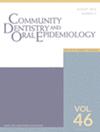Social support associated with restorative treatment, professionally applied fluoride and flossing: A cross-sectional analysis including recent immigrants from Central America and Mexico in the Midwest USA
Abstract
Objectives
This study examined how Mexican and Central American immigrants' social support was associated with three selected dental outcomes among recent immigrants, prior to the 2020 COVID-19 pandemic.
Methods
Using baseline wave data from the 2017–2022 VidaSana study about the health and social networks of Mexican and Central American immigrants living in Indiana, this study utilized logistic and ordinal logistic regression to predict lifetime fluoride use, lifetime dental restoration and flossing frequency, across levels of social support and differences between Mexican and Central American immigrants.
Results
Data from 547 respondents were included in the present analysis (68% women; mean age 34.4 years [SD 11.2]; Central American 42%; Mexican 58%). Results show a high level of social support was associated with increased probability of fluoride use, dental restoration and higher flossing frequency for Mexican immigrants. However, social support for Central American immigrants was associated with a decreased likelihood of fluoride use, more infrequent flossing, and had no significant association with dental restorations experience. What would be a negative association between Central American immigrants and dental restoration was accounted for by education level and never having been to a dentist.
Conclusions
While higher social support was linked to beneficial outcomes for oral health in Mexican immigrants, the opposite was found in Central Americans. These findings highlighted the complexities of social relationships among new immigrants, and potential heterogeneity within the Hispanic population, particularly regarding social and behavioural measures as they pertain to oral health. Further research is needed to identify the underlying mechanisms producing both differences in social support and oral health outcomes.

 求助内容:
求助内容: 应助结果提醒方式:
应助结果提醒方式:


